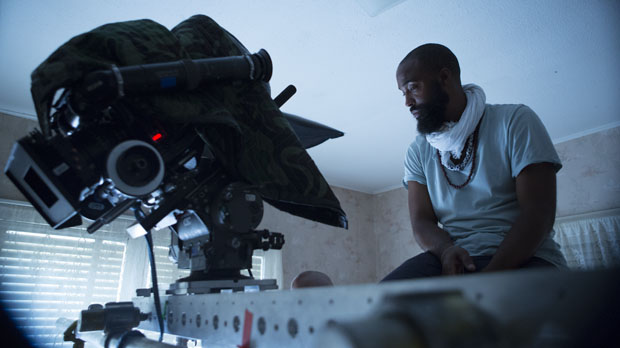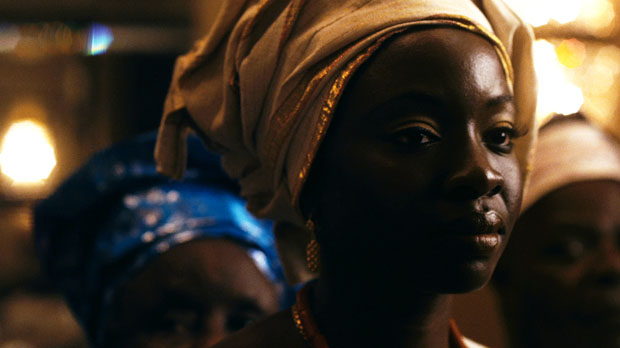 Back to selection
Back to selection
“In the Same Way Painters Used Their Paint…”: D.P. Bradford Young on Ain’t Them Bodies Saints and Mother of George
 Bradford Young on the set of Ain't Them Bodies Saints
Bradford Young on the set of Ain't Them Bodies Saints In just a few years, Bradford Young has emerged as one of the most auspicious and distinctive cinematographers in American independent film. First noticed in 2011 for his work on Andrew Dosunmu’s Restless City and Dee Rees’ Pariah, he was profiled by the New York Times the following year for his subtle, carefully framed cinematography on Ava DuVernay’s Middle of Nowhere.
In just the past year, Young confirmed his early promise with two sumptuous and yet highly disparate visions: for David Lowery’s Texas-set period film Ain’t Them Bodies Saints (opening this week) and Dosunmu’s Brooklyn-based contemporary drama Mother of George (which opens in September). Winner of the Best Cinematography Prize at Sundance 2013 for both films, Young has transcended the time and budgetary limits of low-budget filmmaking to create deeply evocative images, which go beyond mere visual description to reflect a kind of symbolic understanding of the films’ themes and worlds. In the words of the Sundance jury, Young was celebrated for his “expressive use of naturalistic lighting to evoke the state of mind of the characters and the sense of time and place in two very different films.”
Recently, Young spoke with Filmmaker about how he achieved the look of Ain’t Them Bodies Saints and the differences between shooting film and on the Red HD Camera.
Filmmaker: Can you talk about the decision to shoot Ain’t Them Bodies Saints on 35mm film?
Young: The decision was made before I got on, but there was an immediacy and expediency that I thought would do well for the film. Our references were films from the ’60s and ’70s. And I didn’t want to go into post to make that look; I was hoping I could embed that energy into the actual negative. With digital, I would have had a lot of responsibility to make it look like something versus bearing witness to it.
Filmmaker: What specific references were there?
Young: Our references were the mid-career work of Vilmos Zsigmond: Heaven’s Gate and McCabe and Mrs. Miller. We kept saying we wanted the film to look like it was shot through a bottle of bourbon or through a piece of burlap. Vilmos was doing lots of flashing and under-exposing and bleach-retention on the negative — a lot of things in the lab that I felt would be interesting if we could do on this film. We wanted to make a film look really handmade in the 21st Century, which goes back to that film question.
Filmmaker: So how did you achieve that? Did you play with the negative in that way?
Young: We weren’t allowed to. Because of our deal with the bond company, we couldn’t present that much decay on the negative. Vilmos was able to apply that process to intermediate elements, but we weren’t going to have access to an interpositive because we were doing a DI. So we had to really figure out some other ways to create that look on set.
After doing some pretty rigorous testing, we discovered that if we underexposed the film at some pretty uncomfortable levels, the film slipped into a sweet spot. My mantra was I had to underexpose all my day exteriors by three stops. And the way I did that was by sliding an ND9 [filter] in front of the camera. And I would stack more NDs if I wanted. And all my day interiors and night interiors and night exteriors were all underexposed one stop. My gaffer, Christian Epps, was crucial, because he was a gaffer on Clockers, and he had a lot of experience working with challenging negatives. Whenever I would say two stops, he would say three. So it was really gross amounts of under-exposure and a lot of peer pressure that got us in that zone. And what we found was the film became very magenta, brown, and the blacks became very milky, with this very warm, burlap-y, bourbon-y look.
Then Joe Gawler, the colorist, came in on the back end. He had worked with d.p.s who were underexposing the negative to get a heavily textured value to the film, like Harris [Savides] on Greenberg, and he was not scared of what he saw. He got something pretty consistent and strong with the film. So it was a tag team effort.
Filmmaker: The blacks are so rich and beautiful. There is the cliché, which I don’t know if it’s still the case, that digital can’t attain that level of richness. Did you feel the blacks were something special with Ain’t Them Bodies Saints?
Young: I never considered myself a student of painters. But before the creation of blacks, painters had to make their own black paints, so one painter might have more red or green or blue in their blacks just based on their preference. You take one of those 19th-century black paintings, and cut it in half and look at it microscopically and you’re going to see everybody has different layers; someone might have more blue or red layers in their black. So I was trying to build that in the negative rather than the DI and use those layers of emulsion in the same way those painters used their paint. To be honest with you, everything outside of black is a bonus. I always feel if I can nail the blacks, the rest of the film is going to fall into place. It’s an important part of my grammar.
Filmmaker: Can you talk about the way you use natural light in both films?
Young: A lot of that came out of my film school experience at Howard [University]. We didn’t have a lot of resources, so you’re forced to use a lot of available light. For the last few years, I’ve been trying to figure out ways to make things these things look cinematic on a low budget. And with Saints, we had a strict rule that we would only use available light from the period of the film, and whatever sources there were, they couldn’t vibrate; they had to burn. So that narrowed us down to tungsten/incandescent light. The production designer was a big help, and would bring in lamps and lamp shades, warmer or lighter, based on our taste, but in general, it was about lighting with those fixtures.
Filmmaker: But those lights don’t give that much light? You’re shooting on film, and you’ve got these low lights, how are you making it work?
Young: With a film like this, it’s such small quarters, so those lights don’t have to be two feet away; they can be six inches away from the subject. So you can light the film that way. But you’re going to have a thin negative; you’re going to have milky blacks; highlights that are stronger than what you might want; and a little creamier than white, and that leaves a more reddish, brownish look to the film. So once you accept those instruments don’t give off a lot of light, you accept the fact that the film is going to look that particular way.
Someone like Rooney [Mara], she always gave off a stop more than what the meter was reading. So as long as my meter read a f1.4, we knew she was giving a f2. So we shot the whole film at f2. I was nervous about shooting Rooney Mara, and I hadn’t shot actresses of her caliber before. But she was down. And I felt lucky that I could expose somebody like that. It’s like what Harris [Savides] did with Nicole Kidman on Birth. Everyone thought it would be a disaster, but those are some of the best images ever of Kidman. And he cooked the negative way more than we did.

Filmmaker: On Mother of George, I read that you directed a lot of the light from above. What were you doing on Ain’t Them Bodies?
Young: It was the total opposite. Everything had to be from the ground and from the side. The source had to come from somewhere in the frame. So we stayed away from top light; we kept it to either lamps or windows. I just didn’t want that airy wispy light that you can feel and not see and maybe take viewers out of the period.
Filmmaker: What did you shoot Saints with?
Young: The ARRICAM LT and Panavision XL. And 99% of the film was shot on Cooke S4 lenses. And in addition to under-exposure, we kept on a Low Con 1 and Low Con 2 filter at all times, and again, that’s also how you create that milkiness in the image. You can Low Con it in post, but I wanted to build all that into the negative. The Cooke lenses are also soft and Low Con.
Filmmaker: On Mother of George, how much were you familiar with the RED EPIC camera that you used?
Young: Not at all. I didn’t know anything about the camera. All I knew was that it was better than the RED ONE which we shot Restless City on. Mother of George was a [low-budget] film, so I had one day of testing, and I had to figure it out in one day. It was close to the RED ONE and I just prayed that it would hold up. And it did.
Filmmaker: What was it like to shoot those dark skin tones with digital rather than film?
Young: What I like about the RED is that it reminds me of Kodak’s old 6279, a stock that was so colorful with velvety blacks. And I don’t think you’re getting that in contemporary film stocks, which are flat and purely designed to go to DI with and make the look later. 6279 has such a high contrast and I feel like the RED is like that. It actually, in some instances, outperforms film in that way, but in terms of nuance and feeling, you’re missing the grainality of film. But for a story like Mother of George, with all these characters buried in shadow, with these intense colors and reflective textiles, you need the RED, which has this strong bias towards these stronger looking images.
Filmmaker: What are you working on next?
Young: I’m doing commercials with Derek Cianfrance, which has been really interesting. We’re about to do a set of commercials for Ketel One Vodka. With commercials, it gives me the ability to link up with some directors that I really admire.
Filmmaker: It probably gives you more freedom than a Hollywood project would.
Young: The Hollywood gigs are either not happening at all, or the ones that I’m getting, I’m not impressed with. So I figure I might as well stay with my homies in the low-budget world and at least I know we’ll be free and doing projects that we love.
